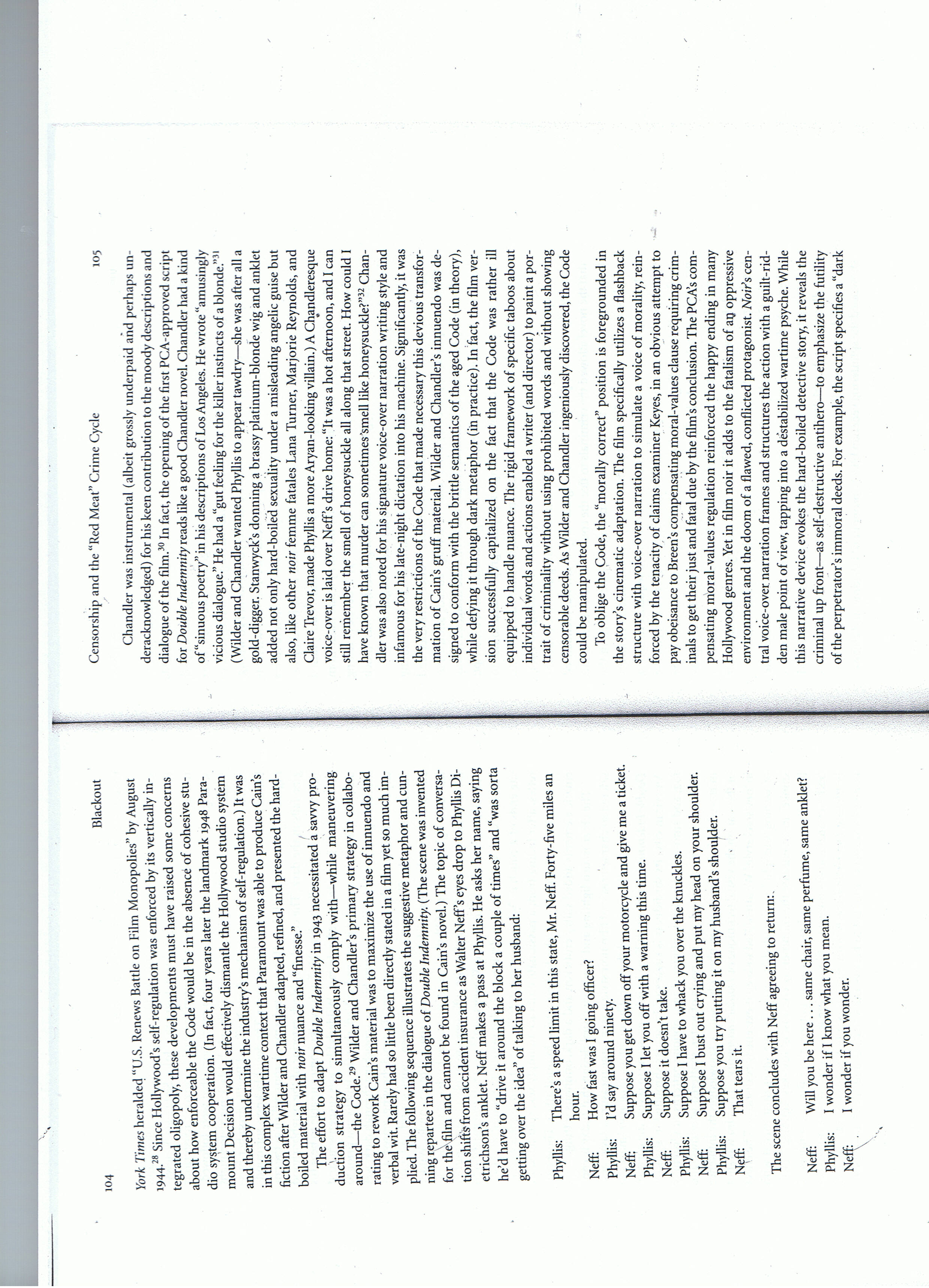censorship, (4)

104
Blackout
York Times heralded “U.S. Renews Battle on Film Monopolies” by August 1944.28 Since Hollywood’s self-regulation was enforced by its vertically in-tegrated oligopoly, these developments must have raised some concerns about how enforceable the Codę would be in the absence of cohesive studio system cooperation. (In fact, four years later the landmark 1948 Para-mount Decision would effectively dismantle the Hollywood studio system and thereby undermine the industrys mechanism of self-regulation.) It was in this complex wartime context that Paramount was able to produce Cains fiction after Wilder and Chandler adapted, refined, and presented the hard-boiled materiał with noir nuance and “finesse.”
The effort to adapt Double Indemnity in 1943 necessitated a sawy pro-duction strategy to simultaneously comply with—while maneuvering around—the Codę.25 Wilder and Chandler’s primary strategy in collabo-rating to rework Cain’s materiał was to maximize the use of innuendo and verbal wit. Rarely had so little been directly stated in a film yet so much im-plied. The following sequence illustrates the suggestive metaphor and cun-ning repartee in the dialogue of Double Indemnity. (The scene was invented for the\film and cannot be found in Cain’s novel.) The topie of conversa-tion shiftsfrom accident insurance as Walter Neff’s eyes drop to Phyllis Di-etrichson’s ankiet. Neff makes a pass at Phyllis. He asks her name, saying he’d have to “drive it around the błock a couple of times” and “was sorta getting over the idea” of talking to her husband:
Phyllis: There’s a speed limit in this State, Mr. Neff. Forty-five miles an
hour.
Neff: How fast was I going officer?
Phyllis: I’d say around ninety.
Neff; Suppose you get down off your motorcycle and give me a ticket. Phyllis: Suppose I let you off with a warning this time.
Neff: Suppose it doesnt take.
Phyllis: Suppose I have to whack you over the knuckles.
Neff: Suppose I bust out erying and put my head on your shoulder.
Phyllis: Suppose you try putting it on my husband’s shoulder.
Neff That tears it.
The scene concludes with Neff agreeing to return:.
Neff: Will you be here ... same chair, same perfume, same ankiet?
Phyllis: I wonder if I know what you mean.
Neff I wonder if you wonder.
V
Censorship and the “Red Meat” Crime Cycle
105
Chandler was instrumental (albeit grossly underpaid and pcrhaps un-deracknowledged) for his keen contribution to the moody descriptions and dialogue of the film.30 In fact, the opening of the first PCA-approved script for Double Indemnity reads like a good Chandler novel. Chandler had a kind of “sinuous poetry” in his descriptions of Los Angeles. He wrote “amusingly vicious dialogue.” He had a“gut feeling for the killer instincts of a blonde.”31 (Wilder and Chandler wanted Phyllis to appear tawdry—she was after all a gold-digger. Stanwyck’s donning a brassy platinum-blonde wig and ankiet added not only hard-boiled sexuality under a misleading angelic guise but also, like other noir femme fatales Lana Turner, Marjorie Reynolds, and Claire Trevor, madę Phyllis a morę Aryan-looking villain.) A Chandleresque voice-over is laid over Neff’s drive home: “It was a hot afternoon, and I can still remember the smell of honeysuckle all along that Street. How could I have known that murder can sometimes smell like honeysuckle?”32 Chandler was also noted for his signature voice-over narration writing style and infamous for his late-night dictation into his machinę. Significantly, it was the very restrictions of the Codę that madę necessary this devious transfor-mation of Cains gruff materiał. Wilder and Chandler’s innuendo was de-signed to conform with the brittle semantics of the aged Codę (in theory), while defying it through dark metaphor (in practice). In fact, the film ver-sion successfully capitalized on the fact that the Codę was rather ill equipped to handle nuance. The rigid framework of specific taboos about individual words and actions enabled a writer (and director) to paint a por-trait of criminality without using prohibited words and without showing censorable deeds. As Wilder and Chandler ingeniously discovered, the Codę could be manipulated.
To oblige the Codę, the “morally correct” position is foregrounded in the story’s cinematic adaptation. The film specifically utilizes a flashback structure with voice-over narration to simulate a voice of morality, rein-forced by the tenacity of claims examiner Keyes, in an obvious attempt to pay obeisance to Breen’s compensating moral-values clause requiring crim-inals to get their just and fatal due by the film’s conclusion. The PCA’s compensating moral-values regulation reinforced the happy ending in many Hollywood genres. Yet in film noir it adds to the fatalism of ag oppressive environment and the doom of a flawed, conflicted protagonist. Noirs central voice-over narration frames and structures the action with a guilt-rid-den małe point of view, tapping into a destabilized wartime psyche. While this narrative device evokes the hard-boiled detective story, it reveals the criminal up front—as self-destructive antihero—to emphasize the futility of the perpetrator’s immoral deeds. For example, the script specifies a “dark
Wyszukiwarka
Podobne podstrony:
London to York Times Up Gentlemen mRI Ii 11 1 filM su Ę31 NM4Py*B ^
censorship, (8) 112 t Blackout year before, RKO could have produced a fabulous film noir of Chand
hg (2) Miroa lua są lud/ie o Mdpriyrodzooych MX»ch... NEW YORK TIMES •MTSHUNC AUTMORS
image002 1099 September "Fiona Brand has become one of my favorite writers." —New York Tim
Skinny Meals Everything You Need to Lose Weight Fast!(1) •7 NEW YORK TIMES bestselling author of&nbs
New York Times Bestselling Aut gj JL_ ATM, i Iią L t* ^ , (?■ jmnMPKwmk j. . Ł ....... WHE ffi jL
YOUR HEART RELONGS IR ME ajDEAN KOONTZ #1 New York Times Bestselling Author ON SALE IN PAPERBACK NOY
New York Times Bestselling Author "Annę Mallory gives classic romance a fresh and delightful
"DREAT.... ONE OF HER BEST." -THE NEW YORK TIMES BARBARA CLEVERLYSTRANGE IMAGES OF DE
więcej podobnych podstron